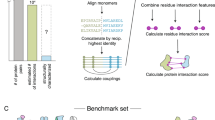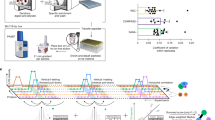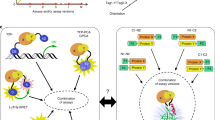Abstract
A large-scale effort to measure, detect and analyse protein–protein interactions using experimental methods is under way1,2. These include biochemistry such as co-immunoprecipitation or crosslinking, molecular biology such as the two-hybrid system or phage display, and genetics such as unlinked noncomplementing mutant detection3. Using the two-hybrid system4, an international effort to analyse the complete yeast genome is in progress5. Evidently, all these approaches are tedious, labour intensive and inaccurate6. From a computational perspective, the question is how can we predict that two proteins interact from structure or sequence alone. Here we present a method that identifies gene-fusion events in complete genomes, solely based on sequence comparison. Because there must be selective pressure for certain genes to be fused over the course of evolution, we are able to predict functional associations of proteins. We show that 215 genes or proteins in the complete genomes of Escherichia coli, Haemophilus influenzae and Methanococcus jannaschii are involved in 64 unique fusion events. The approach is general, and can be applied even to genes of unknown function.
This is a preview of subscription content, access via your institution
Access options
Subscribe to this journal
Receive 51 print issues and online access
$199.00 per year
only $3.90 per issue
Buy this article
- Purchase on Springer Link
- Instant access to full article PDF
Prices may be subject to local taxes which are calculated during checkout



Similar content being viewed by others
References
Mendelsohn,A. R. & Brent,R. Protein interaction methods—toward an endgame. Science 284, 1948–1950 (1999).
Blackstock,W. P. & Weir,M. P. Proteomics: quantitative and physical mapping of cellular proteins. Trends Biotechnol. 17, 121–127 (1999).
Phizicky,E. M. & Fields,S. Protein–protein interactions: methods for detection and analysis. Microbiol. Rev. 59, 94–123 (1995).
Luban,J. & Goff,S. P. The yeast two-hybrid system for studying protein–protein interactions. Curr. Opin. Biotechnol. 6, 59–64 (1995).
Lecrenier,N., Foury,F. & Goffeau,A. Two-hybrid systematic screening of the yeast proteome. BioEssays 20, 1–5 (1998).
Lakey,J. H. & Raggett,E. M. Measuring protein–protein interactions. Curr. Opin. Struct. Biol. 8, 119–123 (1998).
Janin,J. & Rodier,F. Protein–protein interaction at crystal contacts. Proteins 23, 580–587 (1995).
Jones,S. & Thornton,J. M. Principles of protein–protein interactions. Proc. Natl Acad. Sci. USA 93, 13–20 (1996).
Larsen,T. A., Olson,A. J. & Goodsell,D. S. Morphology of protein–protein interfaces. Structure 6, 421–427 (1998).
Dandekar,T., Snel,B., Huynen,M. & Bork,P. Conservation of gene order: a finger-print of proteins that physically interact. Trends Biochem. Sci. 23, 324–328 (1998).
Overbeek,R., Fonstein,M., D'Souza,M., Pusch,G. D. & Maltsev,N. The use of gene clusters to infer functional coupling. Proc. Natl Acad. Sci. USA 96, 2896–2901 (1999).
Tamames,J., Casari,G., Ouzounis,C. & Valencia,A. Conserved clusters of functionally related genes in two bacterial genomes. J. Mol. Evol. 44, 66–73 (1997).
Pellegrini,M., Marcotte,E. M., Thompson,M. J., Eisenberg,D. & Yeates,T. O. Assigning protein functions by comparative genome analysis: protein phylogenetic profiles. Proc. Natl Acad. Sci. USA 96, 4285–4288 (1999).
Bülow,I. Preparation of artificial bifunctional enzymes by gene fusion. Biochem. Soc. Symp. 57, 123–133 (1990).
Wales,M. E. & Wild,J. R. Analysis of structure–function relationships by formation of chimeric enzymes produced by gene fusion. Methods Enzymol. 202, 687–706 (1991).
Burns,D. M., Horn,V., Paluh,J. & Yanofsky,C. Evolution of the tryptophan synthetase of fungi. Analysis of experimentally fused Escherichia coli tryptophan synthetase alpha and beta chains. J. Biol. Chem. 265, 2060–2069 (1990).
Duncan,K., Edwards,R. M. & Coggins,J. R. The Saccharomyces cerevisiae ARO1 gene. An example of the co-ordinate regulation of five enzymes on a single biosynthetic pathway. FEBS Lett. 241, 83–88 (1988).
Denis-Duphil,M. Pyrimidine biosynthesis in Saccharomyces cerevisiae: the ura2 cluster gene, its multifunctional enzyme product, and other structural or regulatory genes involved in de novo UMP synthesis. Biochem. Cell Biol. 67, 612–631 (1989).
Ouzounis,C. A. & Kyrpides,N. C. ThiD-TenA: a gene pair fusion in eukaryotes. J. Mol. Evol. 45, 708–711 (1997).
Smith,S. The animal fatty acid synthase: one gene, one polypeptide, seven enzymes. FASEB J. 8, 1248–1259 (1994).
Welch,G. R. & Easterby,J. S. Metabolic channeling versus free diffusion: transition-time analysis. Trends Biochem. Sci. 19, 193–197 (1994).
Marcotte,E. M. et al. Detecting protein function and protein–protein interactions from genome sequences. Science 285, 751–753 (1999).
Altschul,S. F., Gish,W., Miller,W., Myers,E. W. & Lipman,D. J. Basic local alignment search tool. J. Mol. Biol. 215, 403–410 (1990).
Andrade,M. A. et al. Automated genome sequence analysis and annotation. Bioinformatics 15, 391–412 (1999).
Rivera,M. C., Jain,R., Moore,J. E. & Lake,J. A. Genomic evidence for two functionally distinct gene classes. Proc. Natl Acad. Sci. USA 95, 6239–6244 (1998).
Smith,T. F. & Waterman,M. Identification of common molecular subsequences. J. Mol. Biol. 147, 195–197 (1981).
Pearson,W. R. Effective protein sequence comparison. Methods Enzymol. 266, 227–258 (1996).
Acknowledgements
We thank M. Carroll and S. Searle for technical advice. This work was supported by the European Molecular Biology Laboratory and the TMR Programme of the European Commission DGXII (Science, Research and Development). Patent application filed on behalf of the European Molecular Biology Laboratory.
Author information
Authors and Affiliations
Corresponding author
Supplementary information
Rights and permissions
About this article
Cite this article
Enright, A., Iliopoulos, I., Kyrpides, N. et al. Protein interaction maps for complete genomes based on gene fusion events. Nature 402, 86–90 (1999). https://doi.org/10.1038/47056
Received:
Accepted:
Issue Date:
DOI: https://doi.org/10.1038/47056
This article is cited by
-
A multi-source molecular network representation model for protein–protein interactions prediction
Scientific Reports (2024)
-
Chlorine redox chemistry is widespread in microbiology
The ISME Journal (2023)
-
Genes that are Used Together are More Likely to be Fused Together in Evolution by Mutational Mechanisms: A Bioinformatic Test of the Used-Fused Hypothesis
Evolutionary Biology (2023)
-
Prediction of protein–protein interaction using graph neural networks
Scientific Reports (2022)
-
Robust and accurate prediction of protein–protein interactions by exploiting evolutionary information
Scientific Reports (2021)
Comments
By submitting a comment you agree to abide by our Terms and Community Guidelines. If you find something abusive or that does not comply with our terms or guidelines please flag it as inappropriate.



